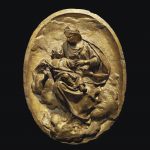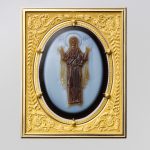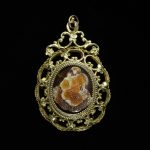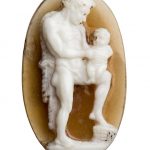Cameos have often depicted the Virgin and Child, especially throughout the Roman Catholic religion. Tender images of the Virgin Mary with her son are among the most beloved in Christian art. Even early images from about the 6th century AD depict her gently cradling or supporting a haloed child or infant on her lap. Devotion to Mary in her dual role as the human mother of Jesus and a divine entity reached a peak in the 14th to 16th centuries, creating great demand for depictions of the mother and child. The term Madonna is Italian for “my lady” and was conferred as a title of respect or high rank, but came to be synonymous with the mother of the holy child and also with the physical representation or manifestation of the two. Small works of art depicting this theme were generally objects of personal worship and prayer intended for intimate use in a private setting, usually a home or a small chapel. Larger and more expansive scenes were produced for altars in public churches, often commissioned by a family or guild as an expression of devotion and an outward display of wealth. Over the centuries different themes emerged, but always with the mother and child as central figures in the scene. Reference: The National Gallery of Art
A late 19th century gilt bronze and cameo inset jewellery casket of waisted canted oval form, with applied foliate and acanthus scrolling corner mounts, the sides with inset pierced figural and floral panels, the hinged lid with an inset Italian oval cameo carved shell plaque depicting the Virgin and Child, 25cm wide, 19cm deep, 13cm high (9 1/2in wide, 7in deep, 5in high)
Sold for £1,062 inc. premium at Bonhams in 2014
Cameo; agate; fragment of larger subject fixed to new ground of same stone, now separated; infant Christ holding apple and supported in two hands of the Virgin. Date16thC
Reference: © The Trustees of the British Museum
AN OVAL GILT TERRACOTTA RELIEF OF THE VIRGIN AND CHILD WORKSHOP OF GIUSEPPE MAZZA (1653-1741), 1701 The reverse inscribed with the date ‘1701’; chips, repaired breaks and minor losses; the gilding probably refreshed 11½ in. (29½ cm.) high
Sold for GBP 5,000 at Christie’s in 2012
Agate cameo of the Virgin and Child
This delicately carved cameo shows the Virgin in an orant pose, with her arms upraised, and a medallion of the Christ Child over her chest. This icon type is often called the Blachernitissa after a famous icon at the Blachernai Monastery in Constantinople.
Reference: The Metropolitan Museum of Art
Gold, Platinum, Agate, Amethyst Cameo and Diamond Virgin Mary Frame The carved amethyst depicting the Virgin Mary measuring approximately 36.0 by 26.7 mm., surrounded by rose-cut diamonds weighing approximately .60 carat, within a carved agate frame measuring approximately 2½ by 1 7/8 inches, signed Je Suis L’Immaculee Conception.
Sold for 6,250 USD at Sotheby’s in 2010
Reliquary pendant in the form of an onyx cameo of the Virgin and Child, set in silver-gilt openwork.
Reference: © Victoria and Albert Museum








